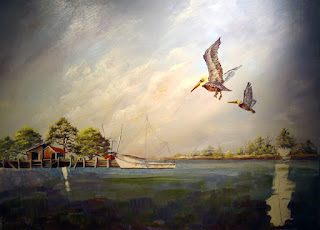When it comes to painting, it is all about the little things.
Men will always question the rigging on a boat or details of a car or motorcycle. Women who garden know the number of petals on a Magnolia and bird lovers can tell you the age of a bird by it detail colouring.....
so, details are important.
Most beginner painters want loads of detail. Older painters with years of experience want a more painterly style and bolder use of colour. We all want an enjoyable experience with more impressive results.
Growing in your art is like all of life. If you continue to add new experiences and challenges, life continues to be filled with joy and that leads to better health. Take the challenge to a better life and get out there and paint!! In my classes I work to give you courage and to inspire you to greater ideas. Anyone who gets the courage to come paint in a small group of strangers deserves this and a fun day of trying new things.
Back to the easel....
I take many little breaks to think thru all my little details on the "big slab," "shrimper" or "trawler."
My shrimp boat is grand and I have painted the sunshine on its hull and cabin with Titanium white adding a little yellow ochre to give it warmth.
The shadows under the cabin are shades of blue and grey-purple to give the shadows life.
As my students know, I rarely use a tube "black" choosing instead to make an "optic black" from
Sap Green,
Ultramarine Blue and
Alizarin Crimson.
If you want a "cool" black, add more blue.
If you want a warm black, just add more red.
If you do not have these colours on your palette, simply use any strong blue, strong red and strong green.... never light shades or hues of anything. For the grey colors of weathered wood...just add a little ochre or white to some of you "optic black" to get a great and alive family of greys.
Why optic black ?
Optic black is an alive black. If you use it to paint the dark openings in your fish shacks or barns, it will not look like a flat black wall, but instead will appear as if it is a space that you can walk into. It has depth.
I challenge you to put your tube of black paint in the drawer and learn to live with more colour in your art.
Painting water !!
Few things are more fun to paint than water.Choose and mix the different colours in your water. Apply using a 1" wide flat brush in short VERTICAL strokes. Once all the canvas and water area is covered in your water colours, take a soft blending brush and using only HORIZONTAL strokes lightly blend the colours....
Make sure you don't over work this or it will not be visually effective.
If you ever get to attend one of my classes or workshops, painting water is often part of my lesson. The same basic technique is very effective in doing skies or backgrounds, with a slightly different twist in the brush work.
Since the water area has a nice "buttery" layer of very juicy paint, I will want to let this dry before I begin my next step. Remember, we are working from the back (far distance) to the front so my marsh grasses, rocks and tree on the back will come in next.
See ya next week with another report!





